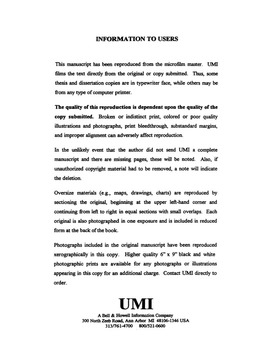| dc.contributor.advisor | Vitt, Laurie J., | en_US |
| dc.contributor.author | Durtsche, Richard D. | en_US |
| dc.date.accessioned | 2013-08-16T12:30:29Z | |
| dc.date.available | 2013-08-16T12:30:29Z | |
| dc.date.issued | 1999 | en_US |
| dc.identifier.uri | https://hdl.handle.net/11244/5786 | |
| dc.description.abstract | The foraging ecology and digestive physiology of a natural size-structured population of iguanid lizards (Ctenosaura pectinata) was studied through two wet and two dry seasons in a tropical deciduous thorn forest in central Mexico. Ctenosaura pectinata shift their diet ontogenetically, with insects constituting 86.5% (by volume) of the juvenile diet and plants dominating the diet of adults. Opportunistic feeding on temporally available insect foods resulted in a broad diet for subadults that potentially benefited juvenile and immature lizards through reduced searching costs, increased nutritional gains due to associative effects, and increased exposure to new food. Digestive tract capacity (both volumetric and length) among all age classes had the architecture of an herbivorous iguanid lizard. | en_US |
| dc.description.abstract | The use of different foods through ontogeny suggests that the nutritional gains depend on the feeding strategy employed. Digestive efficiencies of natural foods were tested in field-based pure diet experiments to determine if nutritional gain correspond to the ontogenetic diet shift. Extraction of energy and nutrients in insect larvae were maximized by juvenile lizards. Calcium, phosphorus, and energy were readily assimilated from flowers and fruit by immature and adult lizards. The xenobiotic effects of one leaf eaten by adults, killed juvenile lizards. Juveniles were less efficient at digesting plant fiber than immature and adult ctenosaurs that assimilated at 50--70%. Ontogenetic differences in ctenosaur digestive physiology suggest that each age class preferred a diet that maximized its physiological benefit. | en_US |
| dc.description.abstract | Through habitat selection, different age classes appeared to gain individual fitness based on body size and feeding strategy. Rock habitats with few food resources offered the highest temperatures (T¯ = 44.7° C) and were dominated by large adult lizards in elevated positions (x¯ = 7.6 m). The predominance of adults and immatures basking in these habitats supports effective digestion of plants by maintaining body temperatures (T¯ b = 34.8° +/- 0.57° C) within the thermal performance range (33° --38° C) for maximum digestion over the longest period of the day. Juveniles were found only in lower elevation plant habitats (x¯ juvenile elevation in shrubs = 1.3 m) where insect foods were abundant. | en_US |
| dc.format.extent | xvii, 157 leaves : | en_US |
| dc.subject | Biology, Animal Physiology. | en_US |
| dc.subject | Biology, Ecology. | en_US |
| dc.subject | Iguanas Mexico. | en_US |
| dc.subject | Iguanas Feeding and feeds. | en_US |
| dc.subject | Biology, Zoology. | en_US |
| dc.title | The ontogeny of diet in the Mexican spiny-tailed iguana, Ctenosaura pectinata: Physiological mechanisms and ecological consequences. | en_US |
| dc.type | Thesis | en_US |
| dc.thesis.degree | Ph.D. | en_US |
| dc.thesis.degreeDiscipline | Department of Biology | en_US |
| dc.note | Adviser: Laurie J. Vitt. | en_US |
| dc.note | Source: Dissertation Abstracts International, Volume: 60-04, Section: B, page: 1396. | en_US |
| ou.identifier | (UMI)AAI9925600 | en_US |
| ou.group | College of Arts and Sciences::Department of Biology | |
